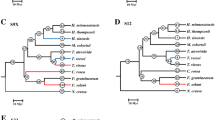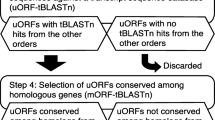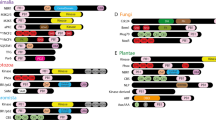Abstract
Pathogenesis-related group 5 (PR5) plant proteins include thaumatin, osmotin, and related proteins, many of which have antimicrobial activity. The recent discovery of PR5-like (PR5-L) sequences in nematodes and insects raises questions about their evolutionary relationships. Using complete plant genome data and discovery of multiple insect PR5-L sequences, phylogenetic comparisons among plants and animals were performed. All PR5/PR5-L protein sequences were mined from genome data of a member of each of two main angiosperm groups—the eudicots (Arabidoposis thaliana) and the monocots (Oryza sativa)—and from the Caenorhabditis nematode (C. elegans and C. briggsase). Insect PR5-L sequences were mined from EST databases and GenBank submissions from four insect orders: Coleoptera (Diaprepes abbreviatus and Biphyllus lunatus), Orthoptera (Schistocerca gregaria), Hymenoptera (Lysiphlebus testaceipes), and Hemiptera (Toxoptera citricida). Parsimony and Bayesian phylogenetic analyses showed that the PR5 family is paraphyletic in plants, likely arising from 10 genes in a common ancestor to monocots and eudicots. After evolutionary divergence of monocots and eudicots, PR5 genes increased asymmetrically among the 10 clades. Insects and nematodes contain multiple sequences (seven PR5-Ls in nematodes and at least three in some insects) all related to the same plant clade, with nematode and insect sequences separating as two clades. Protein structural homology modeling showed strong similarity among animal and plant PR5/PR5-Ls, with divergence only in surface-exposed loops. Sequence and structural conservation among PR5/PR5-Ls suggests an important and conserved role throughout the evolutionary divergence of the diverse organisms from which they reside.









Similar content being viewed by others
References
Abad LR, D’Urzo MP, Liu D, Narasimhan ML, Reuveni M, Zhu JK, Niu X, Singh NK, Hasegawa PM, Bressan RA (1996) Antifungal activity of tobacco osmotin has specificity and involves plasma membrane permeabilization. Plant Sci 118:11–23
Anand A, Zhou T, Trick HN, Gill BS, Bockus WW, Muthukrishnan S (2003) Greenhouse and field testing of transgenic wheat plants stably expressing genes for thaumatin-like protein, chitinase and glucanase against Fusarium graminearum. J Exp Bot 54:1101–1111
Baker B, Zambryski P, Staskawicz B, Nesh-Kumar SP (1997) Signaling in plant–microbe interactions. Science 276:726–733
Batalia MA, Monzingo AF, Ernst S, Roberts W, Robertus JD (1996) The crystal structure of the antifungal protein zeamatin, a member of the thaumatin-like, PR-5 protein family. Nat Struct Biol 3:19–23
Bendtsen JD, Nielsen H, von HG, Brunak S (2004) Improved prediction of signal peptides: SignalP 3.0. J Mol Biol 340:783–795
Brandazza A, Angeli S, Tegoni M, Cambillau C, Pelosi P (2004) Plant stress proteins of the thaumatin-like family discovered in animals. FEBS Lett 572:3–7
Cheong NE, Choi YO, Kim WY, Bae IS, Cho MJ, Hwang I, Kim JW, Lee SY (1997) Purification and characterization of an antifungal PR-5 protein from pumpkin leaves. Mol Cells 7:214–219
Chu KT, Ng TB (2003a) Isolation of a large thaumatin-like antifungal protein from seeds of the Kweilin chestnut Castanopsis chinensis. Biochem Biophys Res Commun 301:364–370
Chu KT, Ng TB (2003b) Mollisin, an antifungal protein from the chestnut Castanea mollissima. Planta Med 69:809–813
Crane PR, Friis EM, Raunsgaard-Pedersen K (1995) The origin and early diversificaiton of angiosperms. Nature 374:27–33
de Vos AM, Hatada M, van der WH, Krabbendam H, Peerdeman AF, Kim SH (1985) Three-dimensional structure of thaumatin I, an intensely sweet protein. Proc Natl Acad Sci USA 82:1406–1409
De LR, V, Mancheno JM, Lanio ME, Onaderra M, Gavilanes JG (1998) Mechanism of the leakage induced on lipid model membranes by the hemolytic protein sticholysin II from the sea anemone Stichodactyla helianthus. Eur J Biochem 252:284–289
Duda TF Jr, Vanhoye D, Nicolas P (2002) Roles of diversifying selection and coordinated evolution in the evolution of amphibian antimicrobial peptides. Mol Biol Evol 19:858–864
Fehlbaum P, Bulet P, Michaut L, Lagueux M, Broekaert WF, Hetru C, Hoffmann JA (1994) Insect immunity. Septic injury of Drosophila induces the synthesis of a potent antifungal peptide with sequence homology to plant antifungal peptides. J Biol Chem 269:33159–33163
Franco OL, Rigden DJ, Melo FR, Grossi-De-Sa MF (2002) Plant alpha-amylase inhibitors and their interaction with insect alpha-amylases. Eur J Biochem 269:397–412
Gómez-Leyva JF, Blanco-Labra A: (2001) Bifunctional a–amylase/trypsin inhibitor activity previously ascibed to the 22 KDa TL protein, resided in a contaminant protein of 14 KDa. J Plant Physiol 158(2):177–183
Green PJ (1995) Reversible jump Markov chain Monte Carlo compuation and Bayesian model determinations. Biometrika 82:711–732
Grenier J, Potvin C, Trudel J, Asselin A (1999) Some thaumatin-like proteins hydrolyse polymeric beta-1,3-glucans. Plant J 19:473–480
Guex N, Peitsch MC (1997) SWISS-MODEL and the Swiss-PdbViewer: an environment for comparative protein modeling. Electrophoresis 18:2714–2723
Hastings MK (1970) Monte Carlo sampling methods using Markov chains and their applications. Biometrika 57:97–109
Hejgaard J, Jacobsen S, Svendsen I (1991) Two antifungal thaumatin–like proteins from barley grain. FEBS Lett 291:127–131
Hoffmann JA, Kafatos FC, Janeway CA, Ezekowitz RA (1999) Phylogenetic perspectives in innate immunity. Science 284:1313–1318
Hong Q, Gutierrez-Aguirre I, Barlic A, Malovrh P, Kristan K, Podlesek Z, Macek P, Turk D, Gonzalez-Manas JM, Lakey JH, Anderluh G (2002) Two-step membrane binding by Equinatoxin II, a pore-forming toxin from the sea anemone, involves an exposed aromatic cluster and a flexible helix. J Biol Chem 277:41916–41924
Hu X, Reddy AS (1997) Cloning and expression of a PR5-like protein from Arabidopsis: inhibition of fungal growth by bacterially expressed protein. Plant Mol Biol 34:949–959
Huelsenbeck JP, Ronquist F (2003) MrBayes 3: Baysian inference under mixed models. Bioinformatics 19:1572–1574
Hurley JH, Misra S (2000) Signaling and subcellular targeting by membrane-binding domains. Annu Rev Biophys Biomol Struct 29:49–79
Huynh QK, Borgmeyer JR, Zobel JF (1992) Isolation and characterization of a 22 kDa protein with antifungal properties from maize seeds. Biochem Biophys Res Commun 182:1–5
Ibeas JI, Lee H, Damsz B, Prasad DT, Pardo JM, Hasegawa PM, Bressan RA, Narasimhan ML (2000) Fungal cell wall phosphomannans facilitate the toxic activity of a plant PR-5 protein. Plant J 23:375–383
Ibeas JI, Yun DJ, Damsz B, Narasimhan ML, Uesono Y, Ribas JC, Lee H, Hasegawa PM, Bressan RA, Pardo JM (2001) Resistance to the plant PR-5 protein osmotin in the model fungus Saccharomyces cerevisiae is mediated by the regulatory effects of SSD1 on cell wall composition. Plant J 25:271–280
Koiwa H, Kato H, Nakatsu T, Oda J, Yamada Y, Sato F (1997) Purification and characterization of tobacco pathogenesis-related protein PR-5d, an antifungal thaumatin-like protein. Plant Cell Physiol 38:783–791
Koiwa H, Kato H, Nakatsu T, Oda J, Yamada Y, Sato F (1999) Crystal structure of tobacco PR-5d protein at 1.8 A resolution reveals a conserved acidic cleft structure in antifungal thaumatin-like proteins. J Mol Biol 286:1137–1145
Larget B, Simon D (1999) Markov chain Mente Carlo algorithms for the baysian analysis of phylogenetic trees. Mol Biol Evol 16:111–120
Lay FT, Schirra HJ, Scanlon MJ, Anderson MA, Craik DJ (2003) The three-dimensional solution structure of NaD1, a new floral defensin from Nicotiana alata and its application to a homology model of the crop defense protein alfAFP. J Mol Biol 325:175–188
Lesk AM (2003) Introduction to protein architecture. Oxford University Press, New York
Li R, Wu N, Fan Y, Song B (1999) Transgenic potato plants expressing osmotin gene inhibits fungal development in inoculated leaves. Chin J Biotechnol 15:71–75
McPherson A, Weickmann J (1990) X-ray analysis of new crystal forms of the sweet protein thaumatin. J Biomol Struct Dyn 7:1053–1060
Metropolis N, Rosenbluth AW, Rosenbluth MN, Teller AH, Teller E (1953) Equations of state calculations by fastr computing machines. J Chem Phys 21:1087–1091
Min K, Ha SC, Hasegawa PM, Bressan RA, Yun DJ, Kim KK (2004) Crystal structure of osmotin, a plant antifungal protein. Proteins 54:170–173
Ng TB (2004) Antifungal proteins and peptides of leguminous and non-leguminous origins. Peptides 25:1215–1222
Nicolas P, Vanhoye D, Amiche M (2003) Molecular strategies in biological evolution of antimicrobial peptides. Peptides 24:1669–1680
Osmond RI, Hrmova M, Fontaine F, Imberty A, Fincher GB (2001) Binding interactions between barley thaumatin-like proteins and (1,3)-beta-D–glucans. Kinetics, specificity, structural analysis and biological implications. Eur J Biochem 268:4190–4199
Rebmann G, Mauch F, Dudler R (1991) Sequence of a wheat cDNA encoding a pathogen–induced thaumatin-like protein. Plant Mol Biol 17:283–285
Roberts W, Selitrennikoff CP (1990) Zeamatin, an antifungal protein from maize with membrane-permeabilizing activity. J Gen Microbiol 136:1771–1778
Salzman RA, Koiwa H, Ibeas JI, Pardo JM, Hasegawa PM, Bressan RA (2004) Inorganic cations mediate plant PR5 protein antifungal activity through fungal Mnn1- and Mnn4-regulated cell surface glycans. Mol Plant Microbe Interact 17:780–788
Schimoler-O’Rourke R, Richardson M, Selitrennikoff CP (2001) Zeamatin inhibits trypsin and alpha-amylase activities. Appl Environ Microbiol 67:2365–2366
Schwede T, Kopp J, Guex N, Peitsch MC (2003) SWISS-MODEL: An automated protein homology-modeling server. Nucleic Acids Res 31:3381–3385
Singh NK. Handa AK, Hasegawa PM, Bressan RA (1985) Protein associated with adaptation of cultured tobacco cells to NaCl. Plant Physiol 79:126–137
Singh NK, Bracker CA, Hasegawa PM, Handa AK, Buckel S, Hermodson MA, Pfankoch E, Regnier FA, Bressan RA (1987) Characterization of osmotin. A thaumatin-like protein associated with osmotic adaptation in plant cells. Plant Physiol 85:529–536
Svensson B, Fukuda K, Nielsen PK, Bonsager BC (2004) Proteinaceous alpha-amylase inhibitors. Biochim Biophys Acta 1696:145–156
Swofford DL (2003) PAUP*: Phylogenetic analysis using parsiomony (*and other methods). Sinauer Associates, Sunderland, MA
Theodorides K, De RA, Gomez-Zurita J, Foster PG, Vogler AP (2002) Comparison of EST libraries from seven beetle species: towards a framework for phylogenomics of the Coleoptera. Insect Mol Biol 11:467–475
Thompson JD, Gibson TJ, Plewniak F, Jeanmougin F, Higgins DG (1997) The CLUSTAL_X windows interface: flexible strategies for multiple sequence alignment aided by quality analysis tools. Nucleic Acids Res 25:4876–4882
Trudel J, Grenier J, Potvin C, Asselin A (1998) Several thaumatin-like proteins bind to beta-1,3-glucans. Plant Physiol 118:1431–1438
van der WH, Loeve K (1972) Isolation and characterization of thaumatin I and II, the sweet-tasting proteins from Thaumatococcus daniellii Benth. Eur J Biochem 31:221–225
Vanhoye D, Bruston F, Nicolas P, Amiche M (2003) Antimicrobial peptides from hylid and ranin frogs originated from a 150-million-year-old ancestral precursor with a conserved signal peptide but a hypermutable antimicrobial domain. Eur J Biochem 270:2068–2081
Vigers AJ, Roberts WK, Selitrennikoff CP (1991) A new family of plant antifungal proteins. Mol Plant Microbe Interact 4:315–323
Vigers AJ, Wiedemann S, Roberts WK, Legrand M, Selitrennikoff CP, Fritig B (1992) Thaumatin-like pathogenesis-related proteins are antifungal. Plant Sci 83:155–161
Vu L, Huynh QK (1994) Isolation and characterization of a 27-kDa antifungal protein from the fruits of Diospyros texana. Biochem Biophys Res Commun 202:666–672
Wang H, Ng TB (2002) Isolation of an antifungal thaumatin-like protein from kiwi fruits. Phytochemistry 61:1–6
Wolfe KH, Gouy Y-W, Sharp PM, Li W-H (1989) Date of the monocot-dicot divergence estimated from chloropast DNA seqeunce data. Proc Natl Acad Sci USA 86:6201–6205
Woloshuk CP, Meulenhoff JS, Sela-Buurlage M, van den Elzen PJ, Cornelissen BJ (1991) Pathogen-induced proteins with inhibitory activity toward Phytophthora infestans. Plant Cell 3:619–628
Ye XY, Wang HX, Ng TB (1999) First chromatographic isolation of an antifungal thaumatin-like protein from French bean legumes and demonstration of its antifungal activity. Biochem Biophys Res Commun 263:130–134
Zhu B, Chen TH, Li PH (1996) Analysis of late-blight disease resistance and freezing tolerance in transgenic potato plants expressing sense and antisense genes for an osmotin-like protein. Planta 198:70–77
Zitzer A, Harris JR, Kemminer SE, Zitzer O, Bhakdi S, Muething J, Palmer M (2000) Vibrio cholerae cytolysin: assembly and membrane insertion of the oligomeric pore are tightly linked and are not detectably restricted by membrane fluidity. Biochim Biophys Acta 1509:264–274
Acknowledgments
The authors would like to acknowledge Dr. Phat Dang, Bryan Backlaski, and Kimberly Poole for their technical assistance.
Author information
Authors and Affiliations
Corresponding author
Additional information
[Reviewing Editor: Dr. Rafael Zardoya]
Rights and permissions
About this article
Cite this article
Shatters, R.G., Boykin, L.M., Lapointe, S.L. et al. Phylogenetic and Structural Relationships of the PR5 Gene Family Reveal an Ancient Multigene Family Conserved in Plants and Select Animal Taxa. J Mol Evol 63, 12–29 (2006). https://doi.org/10.1007/s00239-005-0053-z
Received:
Accepted:
Published:
Issue Date:
DOI: https://doi.org/10.1007/s00239-005-0053-z




